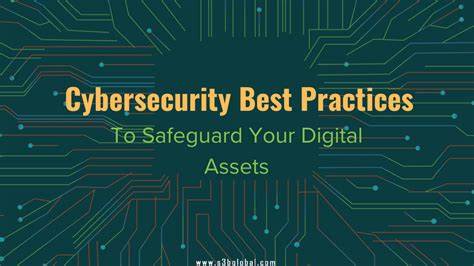Cybersecurity best practices are essential in today's digital landscape, offering protection against a myriad of threats that can compromise sensitive information and disrupt operations. As technology continues to advance, the need for robust cybersecurity measures becomes increasingly critical. Let's delve into the world of cybersecurity best practices to understand how organizations can fortify their defenses and mitigate risks effectively.


Importance of Cybersecurity Best Practices
In today's digital landscape, cybersecurity best practices play a crucial role in protecting sensitive information, preventing data breaches, and safeguarding individuals, organizations, and governments from cyber threats.Potential Risks and Consequences of Neglecting Cybersecurity Best Practices
Neglecting cybersecurity best practices can expose individuals and organizations to a multitude of risks and consequences. These include:- Loss of sensitive data: Failure to implement proper cybersecurity measures can result in the loss of confidential information, such as personal data, financial records, and intellectual property.
- Financial losses: Cyber attacks can lead to financial losses through ransom payments, legal fees, and costs associated with recovering from a breach.
- Damage to reputation: A data breach can severely damage an organization's reputation, leading to loss of customer trust and loyalty.
- Regulatory penalties: Non-compliance with data protection regulations can result in hefty fines and legal consequences.
Examples of High-Profile Cyber Attacks that Could Have Been Prevented
-
Sony Pictures Hack: In 2014, Sony Pictures suffered a devastating cyber attack that resulted in the leak of sensitive company data, emails, and unreleased films. This attack could have been prevented with better cybersecurity practices, such as stronger network security and employee training on phishing scams.
-
Equifax Data Breach: In 2017, Equifax, one of the largest credit reporting agencies, experienced a massive data breach that exposed the personal information of over 147 million individuals. This breach could have been avoided with proper cybersecurity measures, including regular security audits and timely patching of vulnerabilities.
-
WannaCry Ransomware Attack: The WannaCry ransomware attack in 2017 infected hundreds of thousands of computers worldwide, disrupting operations in businesses, hospitals, and government agencies. This attack exploited a known vulnerability for which a security patch was available, highlighting the importance of timely updates and patch management.
Implementing Cybersecurity Best Practices
Implementing cybersecurity best practices within an organization is crucial to safeguard sensitive data and prevent cyber threats. It involves a series of steps and considerations to ensure the security of digital assets.Steps to Implement Cybersecurity Best Practices
- Conduct a Security Assessment: Evaluate current security measures, identify vulnerabilities, and assess potential risks.
- Develop a Security Policy: Define clear guidelines and protocols for data protection, access control, and incident response.
- Implement Access Control Measures: Limit access to sensitive information based on roles and responsibilities.
- Regularly Update Systems and Software: Install security patches and updates to mitigate known vulnerabilities.
- Provide Employee Training: Educate staff on cybersecurity awareness, threats, and best practices.
- Monitor Networks and Systems: Utilize intrusion detection systems and security tools to detect and respond to threats.
- Establish Incident Response Plan: Create a detailed plan to address security incidents promptly and effectively.
Cybersecurity Frameworks and Standards
- NIST Cybersecurity Framework: Provides a comprehensive framework for improving cybersecurity risk management.
- ISO/IEC 27001: Sets international standards for information security management systems.
- CIS Controls: Offers a prioritized set of actions to protect organizations against common cyber threats.
- PCI DSS: Focuses on payment card data security standards for organizations that handle cardholder information.
Tools and Technologies for Cybersecurity
- Firewalls: Monitor and control incoming and outgoing network traffic to prevent unauthorized access.
- Antivirus Software: Detect and remove malware, viruses, and other malicious threats from systems.
- Intrusion Detection Systems (IDS): Monitor network traffic for suspicious activities or security breaches.
- Security Information and Event Management (SIEM) Tools: Collect and analyze security data to identify and respond to security incidents.
- Multi-Factor Authentication (MFA): Enhance access security by requiring multiple forms of verification.
Employee Training and Awareness
Training employees on cybersecurity best practices is crucial in today's digital landscape where cyber threats are constantly evolving. By educating employees about potential risks and how to mitigate them, organizations can significantly reduce the likelihood of falling victim to cyber attacks.Strategies for Raising Awareness
- Conduct regular cybersecurity training sessions for all employees, covering topics such as phishing scams, password security, and data protection.
- Provide real-life examples of cyber attacks and their consequences to help employees understand the importance of following best practices.
- Utilize simulated phishing exercises to test employees' awareness and response to phishing attempts, providing immediate feedback and reinforcement.
- Create a culture of cybersecurity awareness by encouraging employees to report any suspicious activity or security incidents promptly.
Real-Life Scenarios
- Due to an employee's vigilance and quick response to a suspicious email claiming to be from the CEO requesting sensitive information, a potential phishing attack was thwarted, preventing a data breach.
- By raising awareness about the importance of regularly updating software and implementing strong password practices, employees were able to prevent a ransomware attack that targeted outdated systems within the organization.
Data Protection and Encryption
Data protection and encryption play a crucial role in cybersecurity best practices by ensuring that sensitive information remains secure and inaccessible to unauthorized users. Encryption techniques are used to encode data in such a way that only authorized parties with the decryption key can access the information. This helps organizations safeguard their data from cyber threats and maintain the confidentiality and integrity of their information.Encryption Techniques
- Advanced Encryption Standard (AES): AES is a symmetric encryption algorithm widely used for securing sensitive data. It provides a high level of security by encrypting data in blocks of 128 bits.
- Rivest Cipher (RC): RC algorithms are a family of symmetric encryption methods that are known for their simplicity and efficiency in securing data.
- RSA Encryption: RSA is an asymmetric encryption algorithm that uses a pair of keys (public and private) to encrypt and decrypt data. It is commonly used for secure communication and digital signatures.
Impact of Data Breaches and Importance of Encryption
Data breaches can have devastating consequences for organizations, leading to financial losses, reputational damage, and legal repercussions. By implementing encryption techniques, organizations can mitigate the risks associated with data breaches and protect their sensitive information from unauthorized access. Encryption ensures that even if data is compromised, it remains unreadable and unusable to cybercriminals, reducing the impact of a breach on the organization.Incident Response and Disaster Recovery
Incident response and disaster recovery are critical components of any cybersecurity strategy. In the event of a cyber attack, having a well-thought-out plan can help minimize the impact and ensure a swift recovery.Components of an Effective Incident Response Plan
An effective incident response plan typically includes the following components:- Preparation: Establishing roles and responsibilities, creating communication channels, and identifying critical assets.
- Detection and Analysis: Monitoring systems for unusual activities, investigating incidents, and determining the scope of the breach.
- Containment: Isolating affected systems to prevent further damage and mitigate the spread of the attack.
- Eradication: Removing the threat from the system and implementing security patches to prevent future attacks.
- Recovery: Restoring systems to normal operation and implementing additional security measures.
- Lessons Learned: Conducting a post-incident review to identify weaknesses and improve future response efforts.
Importance of Disaster Recovery Planning
Disaster recovery planning is crucial in minimizing the impact of cyber attacks by ensuring that organizations can quickly restore operations and data in the event of a breach. A robust disaster recovery plan includes:- Data Backups: Regularly backing up critical data to prevent data loss.
- Alternative Infrastructure: Establishing secondary systems to maintain operations in case of a system failure.
- Testing and Maintenance: Regularly testing and updating the disaster recovery plan to ensure its effectiveness.
Best Practices for Testing Incident Response and Disaster Recovery Plans
Testing incident response and disaster recovery plans is essential to ensure their effectiveness when a real cyber attack occurs. Best practices for testing include:- Regular Drills: Conducting simulated cyber attack scenarios to test the response plan and identify areas for improvement.
- Collaboration: Involving key stakeholders from different departments to ensure a coordinated response.
- Evaluation: Assessing the effectiveness of the response and recovery efforts and making necessary adjustments.
- Documentation: Documenting the test results and lessons learned to enhance future response strategies.











